CAPTURING REALITY
Born in Banyuwangi in 1971, Nur Ilham is a painter who studied fine arts at the Bali High School of Fine Arts (SMSR). This will currently be Nur Ilham’s first solo exhibition, that will hold at The Jiwa gallery Yogyakarta with the title “Capturing reality”. This theme was inspired by my observations of several of his realistic works about everyday objects using quite artistic aquarelle techniques. The aquarelle technique is a watercolor painting technique that uses wet strokes of transparent colors. Nur holds a high level of sensitivity in capturing the objects he paints naturally and carefully, and sometimes some parts are left to fade and eventually become the artistic part of the painting. The combination of real objects and abstraction is interestingly intertwined in Nur Ilham’s paintings. There is a real sense of sensitivity in capturing the objects of reality expressed in his works.
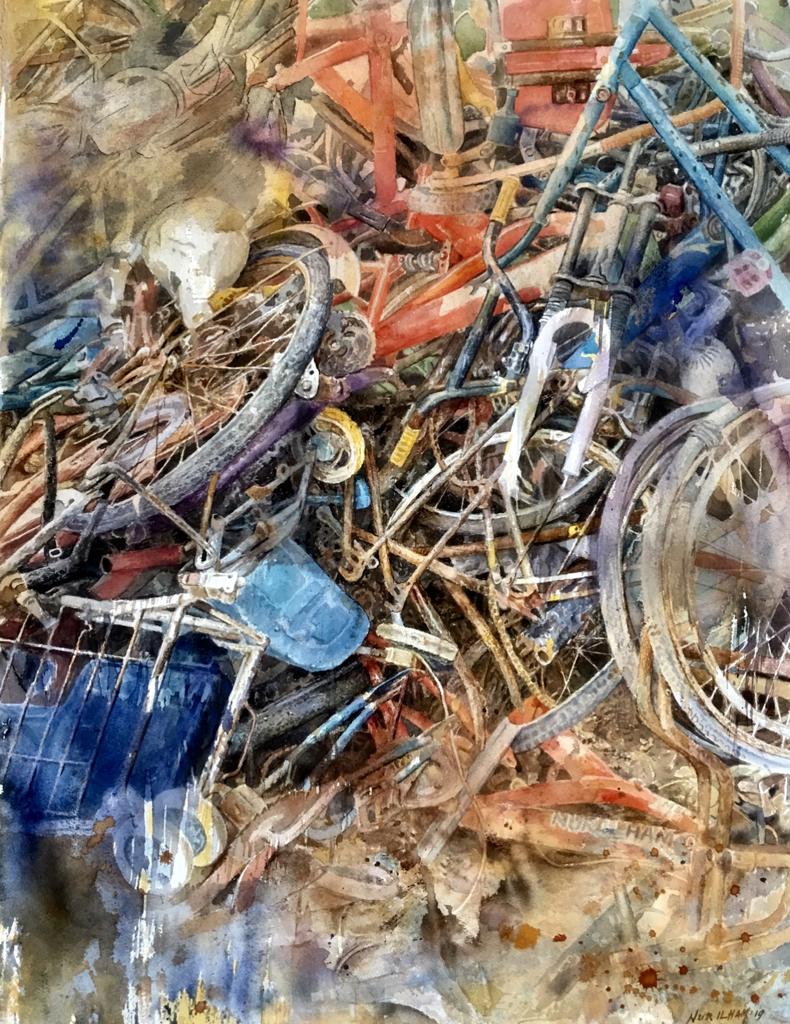
- “Reunion”,watercolor on paper,76X56cm,2019
In Nur Ilham’s work, you can see a combination of ratio and illusion where the object and background are no longer painted as they are but are carefully captured in the character of the object and then processed with a little abstraction. Since realism emerged in the 17th century, right after the era of classicism and romanticism, artists began to think about things that were visible without illusions. In this school, artists like him can immortalize historical moments regarding war or other important events. Likewise, Nur Ilham’s reason for painting realistically is that by using aquarelle and realistic techniques he can immortalize objects and events in a real way. Since 2016, Nur Ilham has started to focus on realist painting using watercolor as an aquarelle technique, which previously he mostly used oil paint. Apart from capturing the moments while painting, the message he conveys can be appreciated easily and realistically. This often happens to realist painters that the message is very important, in contrast to abstract painters whose work has many interpretations and builds a lot of illusions. Let’s look at his work entitled “Clown”, watercolor on paper, 76X56cm, 2022. Painting with a clown in a funny pose dancing with a musical instrument. This painting gives the message that there are some portraits of our society who earn their living from busking on the streets. The painting has an abstract background of mixed colors etched using a wet technique. There is a painting that amazed me, entitled “Reunion”, watercolor on paper, 76X56cm, 2019. A painting depicting a pile of old bicycles with some of the metal rusting. The objects of the bicycles in the painting are done carefully and proportionally, but some of the bicycles, such as spokes, chains, wheels, were made with wet strokes, but the work looks more elegant. The title “Reunion” in the painting gives the meaning that bicycles that were once all new finally meet again in a pile of worn bicycles which Nur Ilham used as a neat painting idea. There is a painting by Nur whose theme, in my opinion, is quite representative of the portrait of the lower class of our society, namely his work entitled “Ending a hard day”, watercolor on paper, 56X38cm, 2023. The painting depicts a man riding a motorbike carrying a pile of used goods that exceeds the capacity of the vehicle he is using. How this is a portrait of a society whose life is very hard to earn a fortune. There are still many of Nur Ilham’s paintings whose themes are quite interesting about the reality he captures.
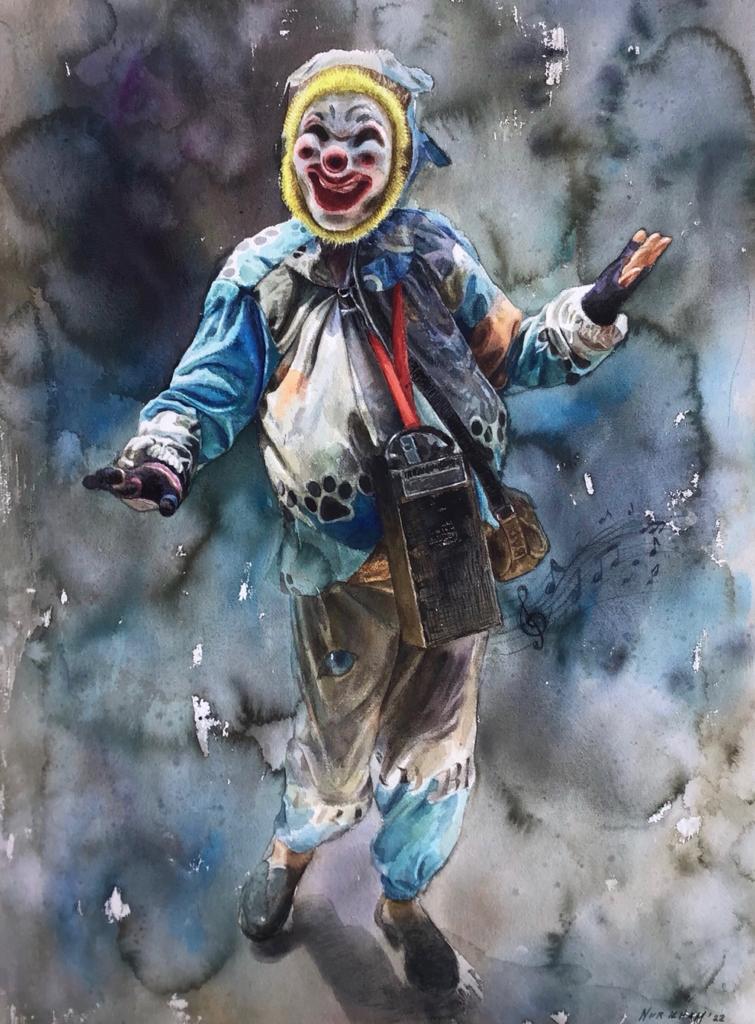
- “Clown”, watercolor on paper,76X56cm,2022
The theme of Nur Ilham’s paintings is generally captures everyday objects that he finds in his life. He captures the object through his senses and then processed it through ideas in a unique and realistic way of thinking. According to Nur, the objects he found in the paintings seemed to be alive and there was a dialogical relationship between him and the objects he painted. This is a spirit that grows within an artist when a marriage occurs between the object and the artist’s idea in an artistic creative process. Nur Ilham paints objects he likes more massively (strongly) than other aquarelle painters who paint a lot of landscapes (natural scenes). In my opinion, painting objects realistically is not easy because it requires great skills and long experience, especially when painting living creatures really requires precise and appropriate anatomical and character proportions. It seems that for Nur Ilham this is his daily habit when creating. When I looked at his paintings one by one, it was clear that Nur was able to work on objects well. He works on a person’s body with detail and precise character, such as sandals, shoes, motorbikes and so on.
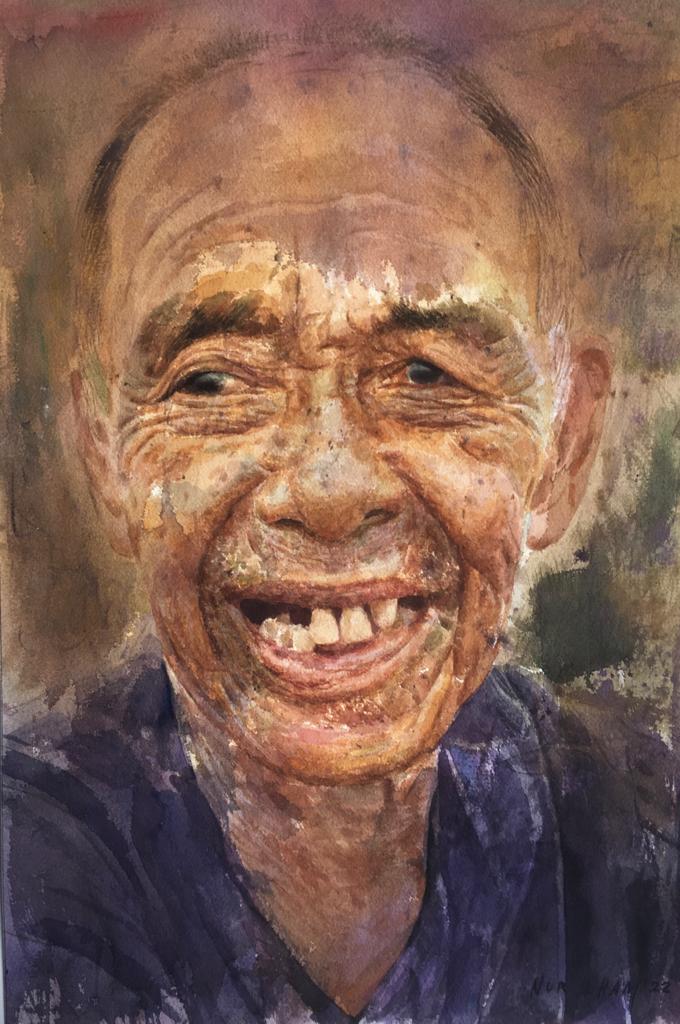
- “Smilling Grandpa “, watercolor on paper,56X36cm,2022
Looking back at the history of Realism, we cannot forget the name of Francisco Goya, a Spanish painter who was born in 1746, where apart from painting, Goya was also a writer. Goya is also considered a pioneer of modern western art who painted many realist objects such as portraits, dogs, exotic women, and historical events in the 18th century. He was very skilled at capturing objects that were painted in a slightly rough but sometimes soft manner and the colors he chose tended to be classic. Goya’s work reflects his daily life, and he views the world without illusions. He painted many portraits and was often commissioned by the court. A quite famous portrait painting is the face of his wife Josefa Bayou or Madame Goya. Gustave Courbet (1819-1877) also expressed the arrogance of a realist painter when he said, “Show me an angel and I will paint it”. Realist painters have an ideology about things that are visible and do not care about things that are fantasy and imaginary. They just paint whatever their eyes see. As technology becomes more advanced, hyper realist painters emerge whose quality of work is equivalent to photography. The hyper realist painters who emerged in the 19th century included Claudio Bravo, a painter from Chile who was born in 1936. The hyper realist painter who became famous when Chinese contemporary art emerged and was appreciated by the world was Leng Jun, born in Sichuan, China in 1963. Where Leng Jun was able to make clothing fibers in detail and women’s hair is worked out perfectly on every strand. His work is very stunning, and the quality is like photography because the detail is so strong. Leng Jun is considered a contemporary Chinese artist, where in the early 2000s was a boom time for Chinese contemporary painting on the world art market.
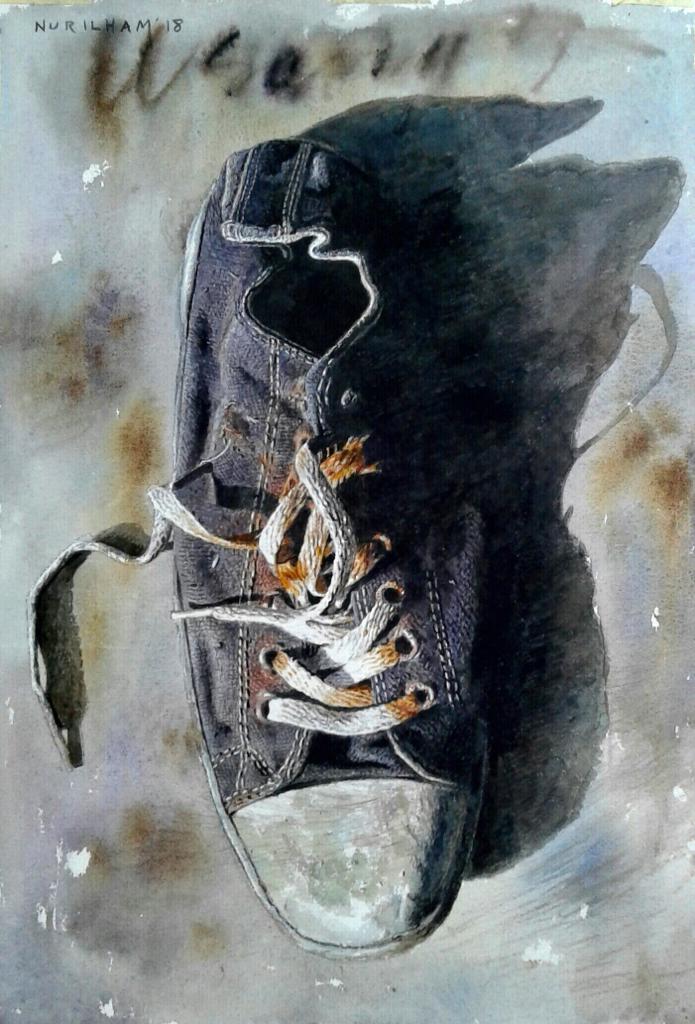
- “Losing the bond”, watercolor on paper,56X38cm,2018
In the last ten years, many Indonesian painters, including Yogyakarta, have become interested in painting natural landscapes (land scape) or painting urban buildings (city scape). These painters often flocked to a chosen location and painted together, as did the group of painters from the Western Impressionist era in the 18th century, such as Claude Monet, Edgar Degas, Auguste Renoir, and others. However, it is different from what Nur Ilham does when painting. He tends to capture objects he likes and then paint them and give them a wet effect on the background he paints. Indeed, the wet technique in aquarelle painting has different artistic characteristics compared to oil paint and acrylic paint. In fact, groups of watercolor painters also have the same preference for using the wet technique (aquarelle) in their work. This aquarelle technique is often depicted on paper rather than canvas because the nature of paper absorbs water more easily and the resulting effect is different from canvas. Initially, Nur Ilham used watercolor as a medium with a dry technique (wet or dry), namely a wet or dry technique. This technique really allows him to achieve detail on all areas of the paper, such as when he uses acrylic paint or oil paint. The technique that Nur also often uses now is the wet-on-wet technique, where the step is to wet clean water onto the paper and then scratch the color according to what you want to depict. The resulting effect is that the colors blend and create an unexpected effect according to the overlapping of the wet etched colors. Nur has been painting with realist techniques for many years and now is a historic moment where he presents his works to the public for appreciation. At least Nur Ilham is one of the quality Indonesian aquarelle painters and his work deserves to be appreciated.
As a curator, I have been very interested in his work for a long time, where Nur Ilham’s work is quite strong semiotically. For me, having a dialogue with his work is something that excites me about all the realities that he immortalizes in his paintings. Congratulations on your current solo exhibition “Capturing reality” and hopefully it will be even more successful.
Jogjakarta, 20 Oktober 2023
Heri Kris, Artist and Curator. Alumni of ISI Jogjakarta

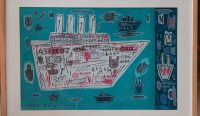




Leave a Reply